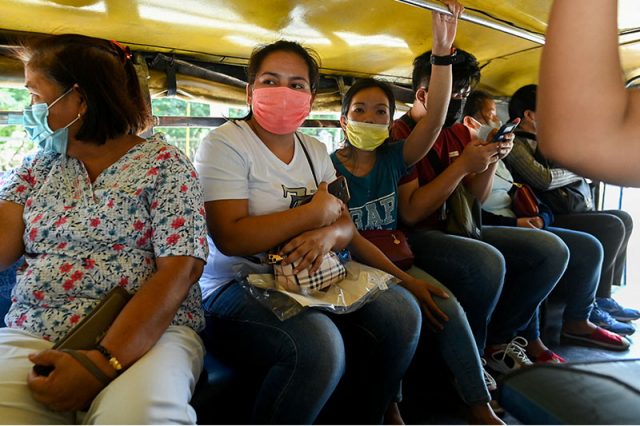
Concerns about the health department’s new policy for quarantine protocols surfaced after it scrapped it out under COVID-19 Alert Level 1.
Health Undersecretary Maria Rosario Vergeire said that fully vaccinated asymptomatic individuals who are close contacts of those who tested positive need not undergo quarantine under this alert level.
“Para po sa Alert Level 1 areas, kung kayo po ay asymptomatic, at close contact kayo ng isang positibong individual, at kayo ay fully vaccinated, wala na pong kailangan o zero days for quarantine pero kailangan niyo po mag-self monitor,” she was quoted in a press briefing on Tuesday.
The health official said that while they are not required to undergo a quarantine, they must continue to monitor themselves for symptoms up to 14 days.
But if the asymptomatic close contact is only partially vaccinated or unvaccinated, he must undergo quarantine for 14 days and monitor himself for symptoms.
Meanwhile, fully vaccinated people who are asymptomatic and have mild COVID-19 need to isolate themselves for seven days from the onset of symptoms or when they test positive.
To asymptomatic and mild cases who are partially vaccinated or unvaccinated, they must isolate for ten days from the onset of symptoms or when they test positive.
Epidemiologist Edsel Salvaña said that the logic behind this is that the “risk of COVID-19 has gotten much lower, and there’s safety margin if you’re vaccinated.”
“Sa Alert Level 1, napakababa na po ng number of people who have COVID-19. The overall picture is ‘yung risk na ‘yun ay mas mababa,” he was quoted as saying.
“Kung bakunado na po tayo, mas mababa po ‘yung chance na mahawa tayo at mababa rin po ang chance na kahit makalusot sa’tin ay makahawa tayo. At sa Alert Level 1, mataas na po ang vaccination,” Salvaña added.
Alert Level 1 is hoisted over areas with the following criteria, according to the Department of Health:
- Case transmission is low and decreasing
- Total bed utilization is less than 50%
- 70% of the area’s target population has been fully vaccinated
- 80% of the area’s target senior citizen population has been fully vaccinated
Under this alert level, businesses and establishments can operate at 100% of their venue capacity while public transportation can operate with a 100% passenger capacity.
Restrictions on the movement of people from different age groups are also lifted, but it is still subject to local government units’ rules.
Despite this, everyone is still expected to adhere to the minimum health protocols such as mask wearing and regular handwashing. Observance of proper ventilation in venues, especially indoors, will also continue.
The DOH’s new quarantine protocol worried some Filipinos who raised concerns about protecting the vulnerable ones such as those with comorbidities and the elderly.
“This is basically passing on the blame and responsibilities entirely to the populace, short of saying balanakayojan (bahala na kayo diyan),” a researcher-teacher tweeted.
“On a serious note, we’re not going to defeat the virus at all with this strategy,” he added.
“So the immunocompromised and the vulnerable are basically left to fend for themselves and can never risk leaving homes?” another Twitter user said in response to the no-quarantine policy.
“I hope this kind of thoughtless decision-making doesn’t end up in another season of lockdown or worse, another variant. Paano na lang ‘yung mga immuno-compromised at persons with comorbidities? Bahala na lang, matira matibay ganern?” a different Filipino wrote.
Health Secretary Francisco Duque III previously said that Metro Manila was already “ripe” to be placed under Alert Level 1.
As of last Thursday, he said that the National Capital Region is at low risk for COVID-19. Less than 30% of the hospital beds are also being used in the region.
Duque also said that 83% of NCR’s senior citizens and more than 100% of its 9.8 million target population are already fully vaccinated.
No more daily case bulletins
The DOH also announced on Tuesday that it will no longer release daily reports of COVID-19 cases starting March 7.
Instead, it will only issue weekly bulletins reporting the number of severe cases and deaths, as well as occupancy rates of hospital intensive care units.
This also concerned some social media users.
“Would this qualify as reckless endangerment?” a Filipino tweeted.
“Wrong move @DOHgovph. People won’t search (on) their own. The daily cases being reported serves as a reminder to people to always be vigilant,” another Twitter user said.
The health agency said that it is to share “more meaningful data” and to “highlight long-term recovery” instead of emphasizing the daily case numbers.
“Gusto natin tanggalin yung mindset ng ating mga kababayan na numero ang tinitignan natin… Ngayon po, kaya natin nililipat kasi mas kritikal and it should be the consquence that the population cares about,” Vergeire explained.
“Kung dumating tayo sa punto na tumataas ulit ang numero ng ating kaso, we will be providing information to the public. Pero ‘yung paglalathala ng severe, critical, at health care utilization ito na po ‘yung magiging permanente na,” she added.
“As to the case number, kung mga mild po ‘yan, we treat it like it’s part of our lives. We live with the virus. ‘Yung severe at critical ang pagtuungan natin ng pansin,” the health official further said.
The DOH tried implementing such a move last year before the Omicron surge.
Filipinos similarly aired concerns about the potential loss of public awareness at that time.
“The importance of the daily case bulletins was to help disseminate the latest COVID-19 numbers in time for the primetime news hour nationwide,” Jason Haw, a doctoral epidemiology student from the John Hopkins Bloomberg School of Public Health, said before.
“I say this as someone who was heavily involved in setting up the COVID-19 surveillance system and the public tracker in 2020,” he added.
RELATED: Why Filipinos want to continue receiving DOH’s daily COVID-19 cases updates









